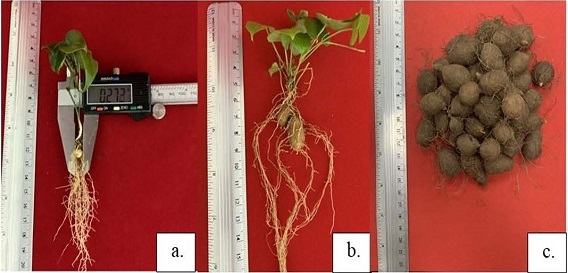Induction of minituber production by rhizobacteria inoculation in yam plants (Dioscorea rotundata Poir)
DOI:
https://doi.org/10.28940/terra.v40i0.1446Keywords:
yam cuttings, seedlings, phytohormones, seed production, shadingAbstract
Yam cultivation is of high importance for the food security of rural families in the Caribbean region of Colombia. One of the main technological problems faced by small yam producers is the low quality and availability of seed for planting. The present work was carried out to evaluate the technology of minitubers production in yam seedlings generated from cuttings, by induction with rhizobacteria. For this purpose, the phytohormone production capacity of three rhizobacteria, identif ied with the codes DCR11 (Azotobacter vinelandii), DSC21 (Brevibacillus laterosporus), and DSC1 (Bacillus licheniformis), was initially evaluated in vitro, and once their capacity was verif ied, an experiment was established under mesh house conditions to induce, with rhizobacteria, the production of mini-tubers in yam seedlings under three levels of shading. A completely randomized experimental design with subdivided plots and three replications was used, where the main plot corresponded to the shade levels (0, 65 and 80%), the subplots to the rhizobacteria (DCR11 A. vinelandii, DSC1 B. licheniformis, DSC21 B. laterosporus), and the sub-subplots at the inoculum doses (0, 2, 4 and 6 mL pl-1). The in vitro results demonstrated the potential of rhizobacteria to produce cytokines and auxins. In mesh house, the capacity of yam seedlings to produce mini-tubers was demonstrated, where the rhizobacteria DSC1 B. licheniformis and DSC21 B. laterosporus showed greater induction capacity. The results demonstrated the feasibility of minitubers production in yam seedlings under mesh house conditions by induction with rhizobacteria, and therefore, its validation at a semi-commercial level is recommended as a strategy for mass production of yam minitubers, as an alternative for the planting of commercial crops.
Downloads
Publication Facts
Reviewer profiles N/A
Author statements
- Academic society
- Terra Latinoamericana
- Publisher
- Mexican Society of Soil Science, C.A.

















